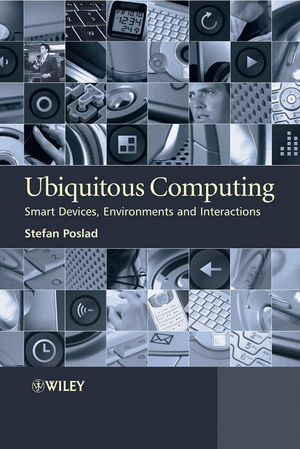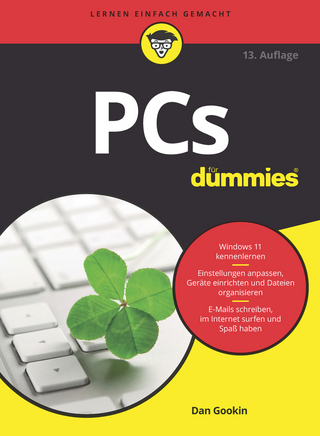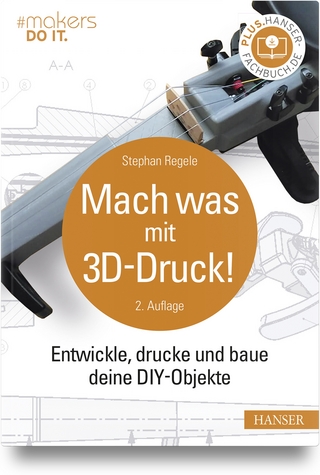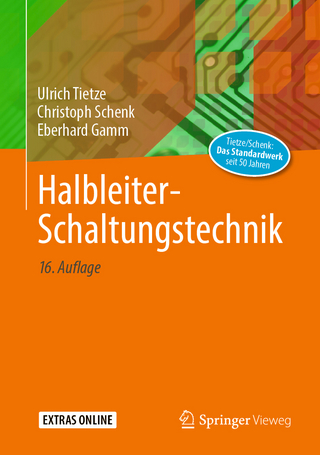
Ubiquitous Computing
John Wiley & Sons Inc (Verlag)
978-0-470-03560-3 (ISBN)
This book provides an introduction to the complex field of ubiquitous computing Ubiquitous Computing (also commonly referred to as Pervasive Computing) describes the ways in which current technological models, based upon three base designs: smart (mobile, wireless, service) devices, smart environments (of embedded system devices) and smart interaction (between devices), relate to and support a computing vision for a greater range of computer devices, used in a greater range of (human, ICT and physical) environments and activities. The author details the rich potential of ubiquitous computing, the challenges involved in making it a reality, and the prerequisite technological infrastructure. Additionally, the book discusses the application and convergence of several current major and future computing trends.
Key Features:
Provides an introduction to the complex field of ubiquitous computing
Describes how current technology models based upon six different technology form factors which have varying degrees of mobility wireless connectivity and service volatility: tabs, pads, boards, dust, skins and clay, enable the vision of ubiquitous computing
Describes and explores how the three core designs (smart devices, environments and interaction) based upon current technology models can be applied to, and can evolve to, support a vision of ubiquitous computing and computing for the future
Covers the principles of the following current technology models, including mobile wireless networks, service-oriented computing, human computer interaction, artificial intelligence, context-awareness, autonomous systems, micro-electromechanical systems, sensors, embedded controllers and robots
Covers a range of interactions, between two or more UbiCom devices, between devices and people (HCI), between devices and the physical world.
Includes an accompanying website with PowerPoint slides, problems and solutions, exercises, bibliography and further reading
Graduate students in computer science, electrical engineering and telecommunications courses will find this a fascinating and useful introduction to the subject. It will also be of interest to ICT professionals, software and network developers and others interested in future trends and models of computing and interaction over the next decades.
Stefan Poslad holds a PhD in computing from the University of Newcastle upon Tyne, UK. He is currently a lecturer and a researcher in the Intelligent Communication Lab at QMUL He has extensive experience at developing and delivering course material in related areas and at applying ambient intelligent approaches involving agents, context aware, smart mobile devices and sensors. Michael Berger has been involved in Computer Science research for the last 12 years, specializing in Computer Supported Cooperative Work (CSCW), Distributed and Ubiquitous Systems as well as Multi-Agent Systems research.? Since 1997 Dr. Berger is a member of the Intelligent Autonomous Systems research group at Siemens Corporate Technology (CT) in Munich and is involved in several technical and team management functions, responsible for product developments in the telematics area and chair of several activities. Since 2002 Dr. Berger has been heading the technology and competence field "Mobile and Ambient Intelligence Technologies" within Siemens CT. Robert M. Patton is a research associate with the Applied Software Engineering Research group of Oak Ridge National Laboratory.? He is currently the principle investigator of the Orion Project, which focuses on the application of intelligent software agents for sensor data fusion. In addition, Dr. Patton works on a number of different projects involving software agents, computational intelligence, and applications to information fusion. Patricia Charlton has over 15 years of research experience in the field of Artificial Intelligence and Multi-Agent systems. This experience covers all aspects from project inception and proposal, through design and implementation, on to end user studies and field trials of the systems developed. This includes being prime coordinator of two large EU projects. Experienced in strategic, management and technical roles within Motorola Labs and author of over 50 papers in the field of AI and multi-agent systems and of 9 filed patents.
List of Figures xix
List of Tables xxiii
Preface xxv
Acknowledgements xxvii
1 Ubiquitous Computing: Basics and Vision 1
1.1 Living in a Digital World 1
1.1.1 Chapter Overview 2
1.1.2 Illustrative Ubiquitous Computing Applications 2
1.1.2.1 Personal Memories 3
1.1.2.2 Adaptive Transport Scheduled Service 5
1.1.2.3 Foodstuff Management 5
1.1.2.4 Utility Regulation 6
1.1.3 Holistic Framework for UbiCom: Smart DEI 7
1.2 Modelling the Key Ubiquitous Computing Properties 8
1.2.1 Core Properties of UbiCom Systems 9
1.2.2 Distributed ICT Systems 9
1.2.2.1 Networked ICT Devices 10
1.2.2.2 Transparency and Openness 10
1.2.3 Implicit Human–Computer Interaction (iHCI) 11
1.2.3.1 The Calm Computer 11
1.2.3.2 Implicit Versus Explicit Human–Computer Interaction 12
1.2.3.3 Embodied Reality versus Virtual, Augmented and Mediated Reality 12
1.2.4 Context-Awareness 13
1.2.4.1 Three Main Types of Environment Context: Physical, User, Virtual 14
1.2.4.2 User-Awareness 14
1.2.4.3 Active Versus Passive Context-Awareness 15
1.2.5 Autonomy 15
1.2.5.1 Reducing Human Interaction 16
1.2.5.2 Easing System Maintenance Versus Self-Maintaining Systems 16
1.2.6 Intelligence 17
1.2.7 Taxonomy of UbiCom Properties 17
1.3 Ubiquitous System Environment Interaction 22
1.3.1 Human–ICT Device Interaction (HCI) 24
1.3.2 ICT Device to Physical World Interaction (CPI) 25
1.4 Architectural Design for UbiCom Systems: Smart DEI Model 26
1.4.1 Smart Devices 27
1.4.1.1 Weiser’s ICT Device Forms: Tabs, Pads and Boards 28
1.4.1.2 Extended Forms for ICT Devices: Dust, Skin and Clay 28
1.4.1.3 Mobility 29
1.4.1.4 Volatile Service Access 29
1.4.1.5 Situated and Self-Aware 30
1.4.2 Smart Environments 30
1.4.2.1 Tagging, Sensing and Controlling Environments 31
1.4.2.2 Embedded Versus Untethered 31
1.4.2.3 Device Sizes 32
1.4.3 Smart Interaction 32
1.4.3.1 Basic Interaction 32
1.4.3.2 Smart Interaction 33
1.5 Discussion 34
1.5.1 Interlinking System Properties, Environments and Designs 34
1.5.2 Common Myths about Ubiquitous Computing 35
1.5.3 Organisation of the Smart DEI Approach 37
Exercises 38
References 39
2 Applications and Requirements 41
2.1 Introduction 41
2.1.1 Overview 41
2.2 Example Early UbiCom Research Projects 41
2.2.1 Smart Devices: cci 42
2.2.1.1 Smart Boards, Pads and Tabs 42
2.2.1.2 Active Badge, Bat and Floor 42
2.2.2 Smart Environments: CPI and cci 43
2.2.2.1 Classroom 2000 43
2.2.2.2 Smart Space and Meeting Room 43
2.2.2.3 Interactive Workspaces and iRoom 44
2.2.2.4 Cooltown 44
2.2.2.5 EasyLiving and SPOT 45
2.2.2.6 HomeLab and Ambient Intelligence 46
2.2.3 Smart Devices: CPI 46
2.2.3.1 Unimate and MH-1 Robots 46
2.2.3.2 Smart Dust and TinyOS 47
2.2.4 Smart Devices: iHCI and HPI 48
2.2.4.1 Calm Computing 48
2.2.4.2 Things That Think and Tangible Bits 48
2.2.4.3 DataTiles 49
2.2.4.4 Ambient Wood 50
2.2.4.5 WearComp and WearCam 50
2.2.4.6 Cyborg 1.0 and 2.0 52
2.2.5 Other UbiCom Projects 52
2.3 Everyday Applications in the Virtual, Human and Physical World 53
2.3.1 Ubiquitous Networks of Devices: cci 53
2.3.2 Human–Computer Interaction 54
2.3.2.1 Ubiquitous Audio-Video Content Access 54
2.3.2.2 Ubiquitous Information Access and Ebooks 55
2.3.2.3 Universal Local Control of ICT Systems 56
2.3.2.4 User-Awareness and Personal Spaces 58
2.3.3 Human-to-Human Interaction (HHI) Applications 58
2.3.3.1 Transaction-based M-Commerce and U-Commerce Services 59
2.3.3.2 Enhancing the Productivity of Mobile Humans 59
2.3.3.3 Care in the Community 60
2.3.4 Human-Physical World-Computer Interaction (HPI) and (CPI) 61
2.3.4.1 Physical Environment Awareness 61
2.3.4.2 (Physical) Environment Control 61
2.3.4.3 Smart Utilities 62
2.3.4.4 Smart Buildings and Home Automation 62
2.3.4.5 Smart Living Environments and Smart Furniture 63
2.3.4.6 Smart Street Furniture 65
2.3.4.7 Smart Vehicles, Transport and Travel 65
2.3.4.8 Pervasive Games and Social Physical Spaces 66
2.4 Discussion 67
2.4.1 Achievements from Early Projects and Status Today 67
2.4.1.1 Smart Devices 67
2.4.1.2 Smart Physical World Environments 68
2.4.1.3 Context-Awareness and Service Discovery 69
2.4.1.4 Wearable Smart Devices and Implants 69
Exercises 71
References 71
3 Smart Devices and Services 75
3.1 Introduction 75
3.1.1 Chapter Overview 75
3.1.2 Smart Device and Service Characteristics 75
3.1.3 Distributed System Viewpoints 77
3.1.4 Abstraction Versus Virtualisation 78
3.2 Service Architecture Models 80
3.2.1 Partitioning and Distribution of Service Components 80
3.2.2 Multi-tier Client Service Models 81
3.2.2.1 Distributed Data Storage 82
3.2.2.2 Distributed Processing 82
3.2.2.3 Client–Server Design 83
3.2.2.4 Proxy-based Service Access 84
3.2.3 Middleware 85
3.2.4 Service Oriented Computing (SOC) 86
3.2.5 Grid Computing 87
3.2.6 Peer-to-Peer Systems 88
3.2.7 Device Models 91
3.3 Service Provision Life-Cycle 91
3.3.1 Network Discovery 92
3.3.2 Service Announcement, Discovery, Selection and Configuration 93
3.3.2.1 Web Service Discovery 95
3.3.2.2 Semantic Web and Semantic Resource Discovery 95
3.3.3 Service Invocation 95
3.3.3.1 Distributed Processes 96
3.3.3.2 Asynchronous (MOM) Versus Synchronous (RPC) Communication Models 97
3.3.3.3 Reliable versus Unreliable Communication 99
3.3.3.4 Caches, Read-Ahead and Delayed Writes 99
3.3.3.5 On-Demand Service Access 100
3.3.3.6 Event-Driven Architectures (EDA) 101
3.3.3.7 Shared Data Repository 103
3.3.3.8 Enterprise Service Bus (ESB) Model 103
3.3.3.9 Volatile Service Invocation 104
3.3.4 Service Composition 105
3.3.4.1 Service Interoperability 106
3.4 Virtual Machines and Operating Systems 106
3.4.1 Virtual Machines 106
3.4.2 Bios 107
3.4.3 Multi-Tasking Operating Systems (MTOS) 108
3.4.4 Process Control 109
3.4.5 Memory Management 110
3.4.6 Input and Output 111
Exercises 111
References 112
4 Smart Mobiles, Cards and Device Networks 115
4.1 Introduction 115
4.1.1 Chapter Overview 115
4.2 Smart Mobile Devices, Users, Resources and Code 115
4.2.1 Mobile Service Design 116
4.2.1.1 SMS and Mobile Web Services 117
4.2.1.2 Java VM and J2ME 119
4.2.1.3 .net Cf 120
4.2.2 Mobile Code 121
4.2.3 Mobile Devices and Mobile Users 122
4.3 Operating Systems for Mobile Computers and Communicator Devices 123
4.3.1 Microkernel Designs 123
4.3.2 Mobility Support 123
4.3.3 Resource-Constrained Devices 124
4.3.4 Power Management 125
4.3.4.1 Low Power CPUs 125
4.3.4.2 Application Support 126
4.4 Smart Card Devices 126
4.4.1 Smart Card OS 127
4.4.2 Smart Card Development 128
4.5 Device Networks 128
4.5.1 HAVi, HES and X 10 129
4.5.2 Device Discovery 129
4.5.3 OSGi 131
Exercises 132
References 133
5 Human–Computer Interaction 135
5.1 Introduction 135
5.1.1 Chapter Overview 135
5.1.2 Explicit HCI: Motivation and Characteristics 136
5.1.3 Complexity of Ubiquitous Explicit HCI 136
5.1.4 Implicit HCI: Motivation and Characteristics 137
5.2 User Interfaces and Interaction for Four Widely Used Devices 138
5.2.1 Diversity of ICT Device Interaction 138
5.2.2 Personal Computer Interface 139
5.2.3 Mobile Hand-Held Device Interfaces 140
5.2.3.1 Handling Limited Key Input: Multi-Tap, T9, Fastap, Soft keys and Soft Keyboard 140
5.2.3.2 Handling Limited Output 141
5.2.4 Games Console Interfaces and Interaction 142
5.2.5 Localised Remote Control: Video Devices 143
5.3 Hidden UI Via Basic Smart Devices 143
5.3.1 Multi-Modal Visual Interfaces 144
5.3.2 Gesture Interfaces 145
5.3.3 Reflective Versus Active Displays 147
5.3.4 Combining Input and Output User Interfaces 148
5.3.4.1 Touchscreens 149
5.3.4.2 Tangible Interfaces 149
5.3.4.3 Organic Interfaces 150
5.3.5 Auditory Interfaces 151
5.3.6 Natural Language Interfaces 151
5.4 Hidden UI Via Wearable and Implanted Devices 152
5.4.1 Posthuman Technology Model 152
5.4.2 Virtual Reality and Augmented Reality 152
5.4.3 Wearable Computer Interaction 153
5.4.3.1 Head(s)-Up Display (HUD) 154
5.4.3.2 Eyetap 154
5.4.3.3 Virtual Retinal Display (VRD) 154
5.4.3.4 Clothes as Computers 155
5.4.4 Computer Implants and Brain Computer Interfaces 155
5.4.5 Sense-of-Presence and Telepresence 157
5.5 Human-Centred Design (HCD) 157
5.5.1 Human-Centred Design Life-Cycle 158
5.5.2 Methods to Acquire User Input and to Build Used Models 159
5.5.3 Defining the Virtual and Physical Environment Use Context 160
5.5.4 Defining the Human Environment Use Context and Requirements 160
5.5.4.1 User Characteristics 160
5.5.5 Interaction Design 161
5.5.5.1 Conceptual Models and Mental Models 162
5.5.6 Evaluation 162
5.6 User Models: Acquisition and Representation 163
5.6.1 Indirect User Input and Modelling 164
5.6.2 Direct User Input and Modelling 164
5.6.3 User Stereotypes 165
5.6.4 Modelling Users’ Planned Tasks and Goals 165
5.6.5 Multiple User Tasks and Activity-Based Computing 166
5.6.6 Situation Action Versus Planned Action Models 167
5.7 iHCI Design 167
5.7.1 iHCI Model Characteristics 167
5.7.2 User Context-Awareness 168
5.7.3 More Intuitive and Customised Interaction 168
5.7.4 Personalisation 169
5.7.5 Affective Computing: Interactions Using Users’ Emotional Context 171
5.7.6 Design Heuristics and Patterns 171
Exercises 175
References 175
6 Tagging, Sensing and Controlling 179
6.1 Introduction 179
6.1.1 Chapter Overview 180
6.2 Tagging the Physical World 180
6.2.1 Life-Cycle for Tagging Physical Objects 181
6.2.2 Tags: Types and Characteristics 181
6.2.3 Physical and Virtual Tag Management 183
6.2.4 RFID Tags 183
6.2.4.1 Active RFID Tags 185
6.2.4.2 Passive RFID Tags 185
6.2.5 Personalised and Social Tags 186
6.2.6 Micro Versus Macro Tags 187
6.3 Sensors and Sensor Networks 187
6.3.1 Overview of Sensor Net Components and Processes 187
6.3.2 Sensor Electronics 189
6.3.3 Physical Network: Environment, Density and Transmission 191
6.3.4 Data Network: Addressing and Routing 192
6.3.4.1 Sensor Networks Versus Ad Hoc Networks 193
6.3.5 Data Processing: Distributed Data Storage and Data Queries 193
6.4 Micro Actuation and Sensing: MEMS 194
6.4.1 Fabrication 195
6.4.2 Micro-Actuators 195
6.4.3 Micro-Sensors 196
6.4.4 Smart Surfaces, Skin, Paint, Matter and Dust 197
6.4.5 Downsizing to Nanotechnology and Quantum Devices 198
6.5 Embedded Systems and Real-Time Systems 199
6.5.1 Application-Specific Operating Systems (ASOS) 200
6.5.2 Real-Time Operating Systems for Embedded Systems 201
6.6 Control Systems (for Physical World Tasks) 202
6.6.1 Programmable Controllers 202
6.6.2 Simple PID-Type Controllers 203
6.6.3 More Complex Controllers 203
6.7 Robots 204
6.7.1 Robot Manipulators 205
6.7.2 Mobile Robots 206
6.7.3 Biologically Inspired Robots 206
6.7.4 Nanobots 207
6.7.5 Developing UbiCom Robot Applications 207
Exercises 209
References 210
7 Context-Aware Systems 213
7.1 Introduction 213
7.1.1 Chapter Overview 214
7.1.2 Context-Aware Applications 214
7.2 Modelling Context-Aware Systems 216
7.2.1 Types of Context 216
7.2.2 Context Creation and Context Composition 218
7.2.3 Context-Aware Adaptation 219
7.2.4 Environment Modelling 221
7.2.5 Context Representation 221
7.2.6 A Basic Architecture 222
7.2.7 Challenges in Context-Awareness 225
7.3 Mobility Awareness 227
7.3.1 Call Routing for Mobile Users 227
7.3.2 Mobile Phone Location Determination 227
7.3.3 Mobile User Awareness as an Example of Composite Context-Awareness 228
7.3.4 Tourism Services for Mobile Users 228
7.4 Spatial Awareness 229
7.4.1 Spatial Context Creation 230
7.4.1.1 Spatial Acquisition 230
7.4.1.2 Location Acquisition 231
7.4.2 Location and Other Spatial Abstractions 233
7.4.3 User Context Creation and Context-Aware Adaptation 233
7.4.3.1 Cartography: Adapting Spatial Viewpoints to Different User Contexts 233
7.4.3.2 Geocoding: Mapping Location Contexts to User Contexts 234
7.4.4 Spatial Context Queries and Management: GIS 234
7.5 Temporal Awareness: Coordinating and Scheduling 235
7.5.1 Clock Synchronization: Temporal Context Creation 235
7.5.2 Temporal Models and Abstractions 236
7.5.3 Temporal Context Management and Adaptation to User Contexts 237
7.6 ICT System Awareness 238
7.6.1 Context-Aware Presentation and Interaction at the UI 238
7.6.1.1 Acquiring the UI Context 238
7.6.1.2 Content Adaptation 239
7.6.2 Network-Aware Service Adaptation 240
Exercises 242
References 242
8 Intelligent Systems (IS) 245
With Patricia Charlton
8.1 Introduction 245
8.1.1 Chapter Overview 246
8.2 Basic Concepts 246
8.2.1 Types of Intelligent Systems 246
8.2.2 Types of Environment for Intelligent Systems 247
8.2.3 Use of Intelligence in Ubiquitous Computing 248
8.3 IS Architectures 249
8.3.1 What a Model Knows Versus How it is Used 249
8.3.1.1 Types of Architecture Model 250
8.3.1.2 Unilateral Versus Bilateral System Environment Models 251
8.3.1.3 Model Representations 252
8.3.1.4 How System Models are Acquired and Adapt 252
8.3.2 Reactive IS Models 252
8.3.3 Environment Model-based IS 254
8.3.4 Goal-based IS 255
8.3.5 Utility-based IS 256
8.3.6 Learning-based IS 256
8.3.6.1 Machine Learning Design 257
8.3.7 Hybrid IS 258
8.3.8 Knowledge-based (KB) IS 260
8.3.8.1 Production or Rule-based KB System 260
8.3.8.2 Blackboard KB System 261
8.3.9 IS Models Applied to UbiCom Systems 261
8.4 Semantic KB IS 263
8.4.1 Knowledge Representation 263
8.4.2 Design Issues 265
8.4.2.1 Open World Versus Closed World Semantics 265
8.4.2.2 Knowledge Life-cycle and Knowledge Management 266
8.4.2.3 Creating Knowledge 266
8.4.2.4 Knowledge Deployment and Maintaining Knowledge 267
8.4.2.5 Design Issues for UbiCom Use 267
8.5 Classical Logic IS 268
8.5.1 Propositional and Predicate Logic 268
8.5.2 Reasoning 269
8.5.3 Design Issues 270
8.6 Soft Computing IS Models 271
8.6.1 Probabilistic Networks 271
8.6.2 Fuzzy Logic 272
8.7 IS System Operations 272
8.7.1 Searching 272
8.7.2 Classical (Deterministic) Planning 274
8.7.3 Non-Deterministic Planning 275
Exercises 276
References 276
9 Intelligent System Interaction 279
With Patricia Charlton
9.1 Introduction 279
9.1.1 Chapter Overview 279
9.2 Interaction Multiplicity 279
9.2.1 P2P Interaction Between Multiple Senders and Receivers 281
9.2.1.1 Unknown Sender and Malicious Senders 281
9.2.1.2 Unknown Receivers 282
9.2.1.3 Too Many Messages 282
9.2.2 Interaction Using Mediators 282
9.2.2.1 Shared Communication Resource Access 283
9.2.2.2 Shared Computation Resource Access 283
9.2.2.3 Mediating Between Requesters and Providers 284
9.2.3 Interaction Using Cooperative Participants 286
9.2.3.1 Coordination 287
9.2.3.2 Coordination Using Norms and Electronic Institutions 289
9.2.3.3 Hierarchical and Role-based Organisational Interaction 290
9.2.4 Interaction with Self-Interested Participants 291
9.2.4.1 Market-based Interaction and Auctions 292
9.2.4.2 Negotiation and Agreements 293
9.2.4.3 Consensus-based Agreements 295
9.3 Is Interaction Design 295
9.3.1 Designing System Interaction to be More Intelligent 296
9.3.2 Designing Interaction Between Individual Intelligent Systems 297
9.3.3 Interaction Protocol Design 297
9.3.3.1 Semantic or Knowledge-Sharing Protocols 298
9.3.3.2 Agent Communication Languages and Linguistic-based Protocols 300
9.3.4 Further Examples of the Use of Interaction Protocols 302
9.3.5 Multi-Agent Systems 303
9.3.5.1 ACL and Agent Platform Design 304
9.3.5.2 Multi-Agent System Application Design 305
9.4 Some Generic Intelligent Interaction Applications 306
9.4.1 Social Networking and Media Exchange 307
9.4.2 Recommender and Referral Systems 308
9.4.2.1 Recommender Systems 308
9.4.2.2 Content-based Recommendations 308
9.4.2.3 Collaborative Filtering 309
9.4.3 Pervasive Work Flow Management for People 309
9.4.4 Trust Management 309
Exercises 311
References 312
10 Autonomous Systems and Artificial Life 317
10.1 Introduction 317
10.1.1 Chapter Overview 317
10.2 Basic Autonomous Intra-Acting Systems 318
10.2.1 Types of Autonomous System 318
10.2.1.1 Autonomous Intelligent Systems 319
10.2.1.2 Limitation of Autonomous Systems 319
10.2.2 Self-* Properties of Intra-Action 320
10.3 Reflective and Self-Aware Systems 322
10.3.1 Self-Awareness 322
10.3.2 Self-Describing and Self-Explaining Systems 323
10.3.3 Self-Modifying Systems Based Upon Reflective Computation 325
10.4 Self-Management and Autonomic Computing 326
10.4.1 Autonomic Computing Design 328
10.4.2 Autonomic Computing Applications 330
10.4.3 Modelling and Management Self-Star Systems 331
10.5 Complex Systems 332
10.5.1 Self-Organization and Interaction 332
10.5.2 Self-Creation and Self-Replication 335
10.6 Artificial Life 336
10.6.1 Finite State Automata Models 336
10.6.2 Evolutionary Computing 337
Exercises 338
References 339
11 Ubiquitous Communication 343
11.1 Introduction 343
11.1.1 Chapter Overview 344
11.2 Audio Networks 344
11.2.1 PSTN Voice Networks 344
11.2.2 Intelligent Networks and IP Multimedia Subsystems 345
11.2.3 ADLS Broadband 346
11.2.4 Wireless Telecoms Networks 346
11.2.5 Audio Broadcast (Radio Entertainment) Networks 347
11.3 Data Networks 347
11.3.1 Network Protocol Suites 348
11.3.2 Addressing 348
11.3.3 Routing and Internetworking 349
11.4 Wireless Data Networks 350
11.4.1 Types of Wireless Network 350
11.4.2 WLAN and WiMAX 352
11.4.3 Bluetooth 353
11.4.4 ZigBee 353
11.4.5 Infrared 354
11.4.6 Uwb 354
11.4.7 Satellite and Microwave Communication 354
11.4.8 Roaming between Local Wireless LANs 355
11.5 Universal and Transparent Audio, Video and Alphanumeric Data Network Access 356
11.5.1 Combined Voice and Data Networks 357
11.5.2 Combined Audio-Video and Data Content Distribution Networks 358
11.5.3 On-demand, Interactive and Distributed Content 360
11.6 Ubiquitous Networks 360
11.6.1 Wireless Networks 360
11.6.2 Power Line Communication (PLC) 361
11.6.3 Personal Area Networks 362
11.6.4 Body Area Networks 362
11.6.5 Mobile Users Networks 363
11.6.5.1 Mobile Addresses 363
11.6.5.2 Single-Path Routing 364
11.6.5.3 Multi-Path Routing in Mobile Ad hoc Networks (MANETs) 364
11.7 Further Network Design Issues 365
11.7.1 Network Access Control 365
11.7.2 Ubiquitous Versus Localised Access 366
11.7.3 Controlling Network Access: Firewalls, NATs and VPNs 367
11.7.4 Group Communication: Transmissions for Multiple Receivers 368
11.7.5 Internetworking Heterogeneous Networks 368
11.7.6 Global Use: Low-Cost Access Networks for Rural Use 369
11.7.7 Separating Management and Control from Usage 369
11.7.8 Service-Oriented Networks 370
11.7.8.1 Service-Orientation at the Network Edge 371
11.7.8.2 Content-based Networks 372
11.7.8.3 Programmable Networks 372
11.7.8.4 Overlay Networks 372
11.7.8.5 Mesh Networks 373
11.7.8.6 Cooperative Networks 375
Exercises 375
References 376
12 Management of Smart Devices 379
12.1 Introduction 379
12.1.1 Chapter Overview 380
12.2 Managing Smart Devices in Virtual Environments 380
12.2.1 Process and Application Management 380
12.2.2 Network-Oriented Management 380
12.2.2.1 Fcaps 382
12.2.3 Monitoring and Accounting 383
12.2.3.1 Icmp 384
12.2.3.2 Snmp 384
12.2.4 Configuration Management 386
12.2.5 Security Management 386
12.2.5.1 Encryption Support for Confidentiality, Authentication and Authorisation 388
12.2.5.2 Securing the System and its Middleware 389
12.2.5.3 Securing Access Devices 391
12.2.5.4 Securing Information 392
12.2.6 Fault Management 393
12.2.7 Performance Management 394
12.2.8 Service-Oriented Computer Management 395
12.2.8.1 Metrics for Evaluating the Use of SOA 395
12.2.8.2 Distributed Resource Management and the Grid 396
12.2.8.3 SLA Management of Services 397
12.2.8.4 Policy-based Service Management 397
12.2.8.5 Pervasive Work Flow Management for Services 398
12.2.9 Information Management 399
12.2.9.1 Information Applications 399
12.2.9.2 Rich Versus Lean and Soft Versus Hard Information 399
12.2.9.3 Managing the Information Explosion 400
12.2.9.4 Managing Multimedia Content 401
12.2.9.5 Managing Lean and Hard Data Using RDBMSs 402
12.2.9.6 Managing Metadata 403
12.3 Managing Smart Devices in Human User-Centred Environments 404
12.3.1 Managing Richer and Softer Data 404
12.3.2 Service Management Models for Human User and Physical Environments 404
12.3.3 User Task and Activity-Based Management 407
12.3.4 Privacy Management 407
12.3.4.1 Biometric User Identification 408
12.3.4.2 Privacy-Invasive Technologies versus Privacy-Enhanced Technologies 410
12.3.4.3 Entrusted Regulation of User Privacy to Service Providers 411
12.3.4.4 Legislative Approaches to Privacy 412
12.4 Managing Smart Devices in Physical Environments 412
12.4.1 Context-Awareness 412
12.4.1.1 Context-Aware Management of Physical and Human Activities 413
12.4.1.2 Management of Contexts and Events 413
12.4.2 Micro and Nano-Sized Devices 415
12.4.3 Unattended Embedded Devices 415
Exercises 416
References 416
13 Ubiquitous System: Challenges and Outlook 421
13.1 Introduction 421
13.1.1 Chapter Overview 421
13.2 Overview of Challenges 422
13.2.1 Key Challenges 422
13.2.2 Multi-Level Support for UbiCom Properties 423
13.2.3 Evolution Versus Revolution 424
13.2.4 Future Technologies 424
13.3 Smart Devices 425
13.3.1 Smaller, More Functional Smart Devices 425
13.3.2 More Fluid Ensembles of Diverse Devices 426
13.3.3 Richer System Interaction and Interoperability 427
13.3.3.1 Migrating from Analogue to Digital Device Interaction 427
13.3.3.2 Richer Digital Device Interaction 428
13.4 Smart Interaction 428
13.4.1 Unexpected Connectivity: Accidentally Smart Environments 428
13.4.2 Impromptu Service Interoperability 429
13.5 Smart Physical Environment Device Interaction 430
13.5.1 Context-Awareness: Ill-Defined Contexts Versus a Context-Free World 430
13.5.2 Lower Power and Sustainable Energy Usage 431
13.5.3 ECO-Friendly UbiCom Devices 433
13.6 Smart Human–Device Interaction 436
13.6.1 More Diverse Human–Device Interaction 437
13.6.2 More Versus Less Natural HCI 439
13.6.3 Analogue to Digital and Digital Analogues 439
13.6.4 Form Follows Function 440
13.6.5 Forms for Multi-Function Devices 441
13.7 Human Intelligence Versus Machine Intelligence 441
13.7.1 Posthuman: ICT Augments Human Abilities Beyond Being Human 443
13.7.2 Blurring of Reality and Mediated Realities 444
13.8 Social Issues: Promise Versus Peril 444
13.8.1 Increased Virtual Social Interaction Versus Local Social Interaction 446
13.8.2 UbiCom Accessible by Everyone 446
13.8.3 UbiCom Affordable by Everyone 447
13.8.4 Legislation in the Digital World and Digitising Legislation 448
13.9 Final Remarks 450
Exercises 451
References 452
Index 455
| Erscheint lt. Verlag | 1.5.2009 |
|---|---|
| Reihe/Serie | Wiley Series in Agent Technology |
| Verlagsort | New York |
| Sprache | englisch |
| Maße | 177 x 254 mm |
| Gewicht | 1049 g |
| Themenwelt | Mathematik / Informatik ► Informatik ► Netzwerke |
| Informatik ► Weitere Themen ► Hardware | |
| Technik ► Elektrotechnik / Energietechnik | |
| ISBN-10 | 0-470-03560-9 / 0470035609 |
| ISBN-13 | 978-0-470-03560-3 / 9780470035603 |
| Zustand | Neuware |
| Informationen gemäß Produktsicherheitsverordnung (GPSR) | |
| Haben Sie eine Frage zum Produkt? |
aus dem Bereich


